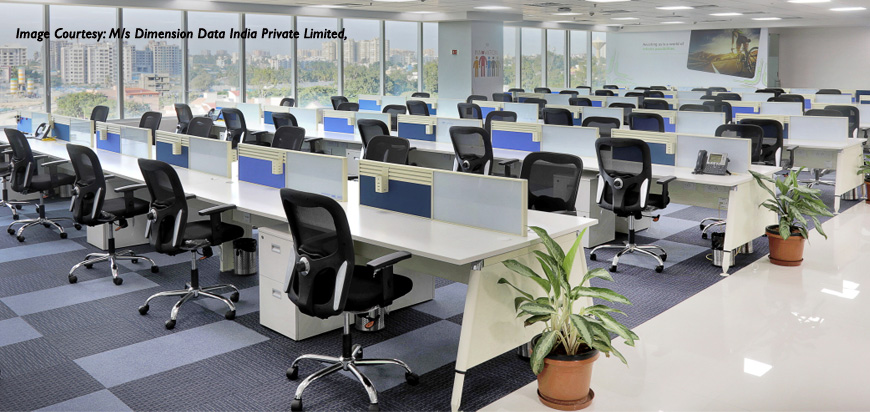Commercial Office Work Space Design
A Fundamental shift has occurred in our world and the ways we work, and it’s one that has had a profound impact on the places and spaces where we work. Commercial office planning strategies have continued to not only affect the overall square feet allotted per person in current work environments, but also affect:
The way in which works gets done
Communication and collaboration
Knowledge transfer
Morale and atmosphere
Health and wellbeing at work;
and many other non-furniture related details
In addition, the growth of the mobile worker has challenged traditional work space allocation and assignments. A standards and planning approach that supports collaboration, flexibility, mobility, adjustability and technology is the key to creating successful, effective, and efficient work environments.
Standardization on fabrics, furnishings, work station sizes, panel heights and components are essential to achieve visual consistency and flexibility while keeping projects affordable.
How you decide to capitalize the business is called your capital formation strategy. There are undoubtedly a number of other factors to consider depending on your company’s current circumstances, and, quite importantly, where you want your company to go in the next few years. If you are still hesitating what development strategy to pick for your company.
Standardization on fabrics, furnishings, work station sizes, panel heights and components are essential to achieve visual consistency and flexibility while keeping projects affordable.
Provide effective and efficient work space
Provide long-term flexibility
Promote collaboration
Sustain existing building space by minimizing the impact of future modifications to administrative office environments
Are achieved and procured at an appropriate cost and level of quality
Workstations IT/ ITES Industry
Percentage of I space to We Space:
70% I space,
30% We space
Select the Right Workstations as per the industry requirements: SOFTWARE DEVELOPMENT OFFICES: L- Type of workstation of 5’x 4’ or 5’x 5’ or even 6’x 6’for 2 monitors etc, a little privacy is thus maintained with a personalized space. However eyelevel openness may be maintained by keeping the above table top screens of low heights. Aggregate Gross Square Foot Allocation per seat: 100 sft. **Some Clients also prefer Large linear workstation of 5’x 2’sizing for achieving increased occupancy.
TECHNOLOGY COMPANIES: L- Type of workstation or Even Private Cubicles with 6’x6’or 7’x 7’work benches and sometimes with multi-tier options as well, for the need of testing/ monitoring etc. Aggregate Gross Square Foot Allocation per seat: 150- 180 sft.
ITES: 120 Degree type -Honeycomb design, Linear Workstations, Hexagonal, Pinwheel etc., with more open concepts with Maximum no of seating and increased occupancy. Aggregate Gross Square Foot Allocation per seat: 30- 50 sft.
Other factors include the following:
Open Office with good Natural Lights.
Hot desks & Agile Seating’s are other addons especially for quick meetings over a coffee or for the Visitor Co-employees from other office locations.
Open office with flexibility to assign for AHM as well.
Design & align workstations (may be at a desired location) in such a manner that it can have a flexibility to convert it in to ODCs without any major changes in services.
We can also opt for height adjustable table for certain areas
Common Areas & Concepts used in recent offices
Breakouts & Collaborative, De-Stressing spaces at regular intervals for team productivity spaces. Innovation centre (breakout cum library space) with collaborative and informal seats. The same is also used as a gathering space for various Promotional Programs which the company organizes at regular intervals for university students and other firms on some public holidays and weekends. This place can also be a lobby surrounded by telephone kiosks cum small interview rooms. A place which can also be used for recruitment drives and HR soft skill programs.
Personal productivity spaces which is mainly for extended working hours. This can be an extension of the conventional retiring rooms but also with some spill overs for listening to music, television, watching videos etc. as a highly acoustically treated capsule rooms.
A trend of providing informal seating like hammock & swings is also seen nowadays. The whole idea behind this is to give a homelier feel to the office rather than making it very cluttered with only work benches and thus leading to be claustrophobic & fatigue.
Server Room, Electrical/UPS
Centralized Location for Server/ UPS room for uniform & optimized utilization of cable length etc.
Meeting rooms & Conference rooms
Rules of thumb are 29"-30" of table space per chair, 3 1/2' to 4' of space between the table and the wall
Small 4/6 meeting rooms can size easily in the range of 15'x12' or 12’x12’ etc
Ratio of people to number of Meeting Spaces should be minimum of 20:1
Usage of Energy saving techniques and materials like LED lights, Inverter ACS, Green Certified materials. Centralized & easy accessible common spaces like Meetings rooms, Conference, printer & reprographic areas.
